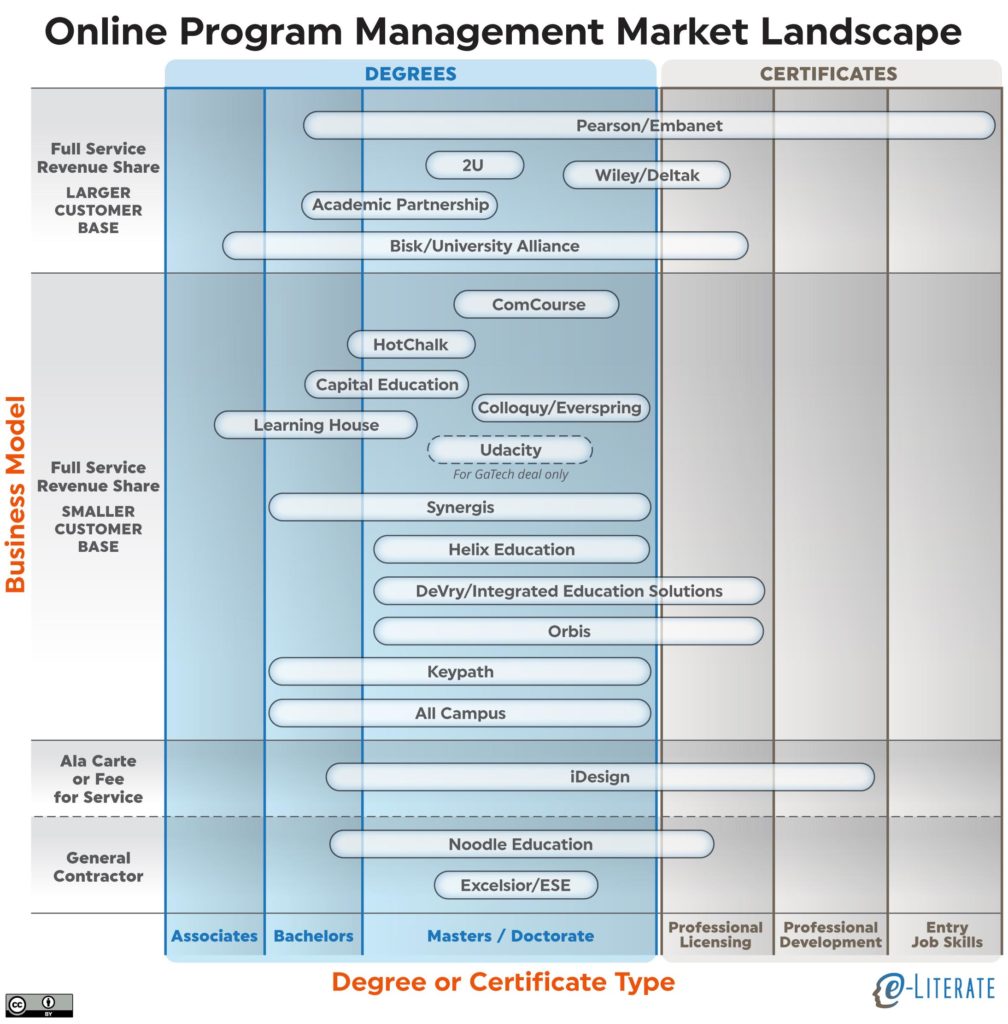One of the fastest-growing market segments in ed tech, and one of the least-understood, is that of Online Program Management (OPM). It doesn’t help that the terms OPM, Online Enablers, Online Service Providers are used interchangeably, although OPM is the most common now.
OPM providers are organizations (mostly for-profit companies, but with at least one non-profit variation) that help non-profit schools develop online programs, most often for Master’s level programs. These providers provide various services for which traditional institutions historically have not had the experience or culture to support. Some examples of the services include marketing & recruitment, enrollment management, curriculum development, online course design, student retention support, technology hosting, and student and faculty support.
It would be useful to go beyond the label and get a broader view.
The biggest question is what type of program is being enabled. The OPM providers are helping with both degree and certificate programs. The majority focus on non-traditional students (i.e. what has become the majority of US higher ed), as working adults often working on degree completion or professional development of some sense.
The sweet spot of the market has been masters programs, but there are some OPM vendors also working with associates and bachelors programs. Certificates and direct ties to employment is a growing field, but even there there are differences – entry job skills, prof dev, career advancement.
The other big question is what is the type of business model. There are five big players, in terms of number of clients and revenue, that most people know about. These are full-service, mostly tuition revenue-sharing. There are a growing number of similar companies who are not (yet) as large as the big 5. There are also firms taking a different approach, more ala carte and fee-based instead of tuition revenue sharing.
For schools, when this model works they get a revenue-producing online program that simply would not have existed without the help. Beyond the services provided, traditionally the OPM market has used a tuition revenue-sharing agreement, with upwards of 50-70% of tuition going to the OPM providers. Because the development and marketing costs come up front the in the agreement while the enrollment-driven revenue comes years later, this means that OPM providers effectively finance a new online program to the tune of millions of dollars. Usually the OPM providers do not break even until years 3 – 5, which is one reason the contracts are often 7 – 10 years.
For the vendors, when this model works they get a far higher revenue per student that would have been possible with platforms sales or other fee-for-service approaches. As I described in a post about 2U, that company makes $10k – $15k per student per year, whereas an LMS vendor might make $20 per student per year. While 2U is the high end of the market and not all OPM vendors get that kind of revenue, we are talking about several orders of magnitude difference per student.
The model does not always work, however, as we have pointed out in our coverage of UF Online and Cal State Online.
The market is becoming crowded and changing in some significant areas. Two changes in particular:
- Both vendors and institutions are trying to make this model work outside of Master’s level programs, venturing into Bachelor’s and even Associate’s degrees and into non-degree programs;
- There are several companies – including some traditional vendors – that are moving beyond the revenue-sharing business model and into fee-for-service models.
To give a sense of the market landscape, I have shown many of the OPM vendors against the program type and the business model. We will explore this landscape in more detail in future posts.

We’d love to have your feedback on this graphic – corrections, comments, questions . . . bring it on.
Excellent research.
For the graphic?
Under “Degrees”, swap “MA/PHD” with “Association.” Makes for a better spectrum.
For “Business Model”, somehow show that the two “Full Service Revenue Share”s are connected. Maybe use a similar shade, or add a bracket.
This is in response to Jeff Shelstad’s comment and citation of the Atlantic article:
Does no one besides me notice the possible conflict of interest in John Katzman’s current position?
I’m not sure the method in which a company gets paid is entirely relevant, but rather just a business model choice, since, as far as I know, all admission/achievement/pricing decisions are made by the universities involved, not their service providers. Is this incorrect?
If a campus would rather pay defined fees (and thus take a bigger risk,) rather than share tuition, that is, of course, their choice, and would likely reward them better if they are successful (but cost them more if they are not.)
Bryan – thanks for feedback (slow reply due to trip and lack of desire to type with thumbs).
No worries. I understand.
Say, would you be interested in being on my Future Trends Forum this summer, to talk LMSes?
Bryan – sure. email phil at mindwires com